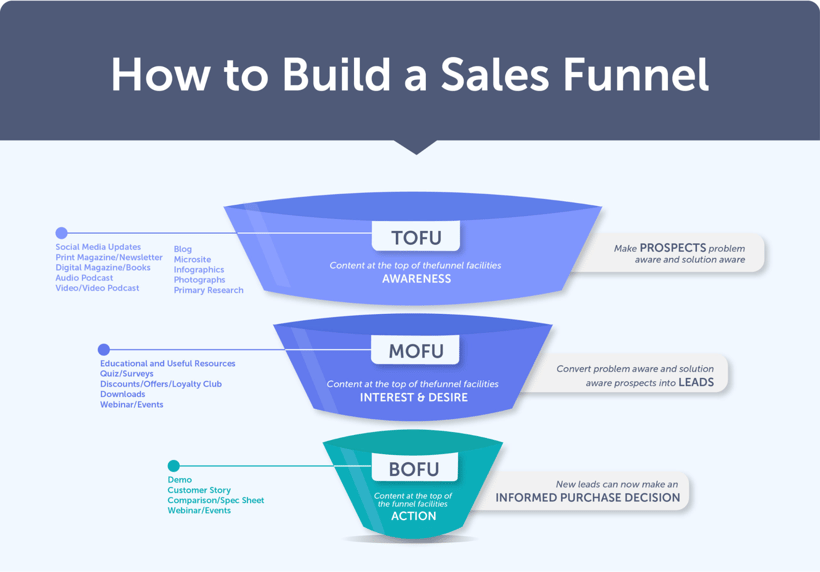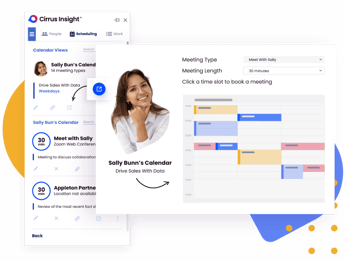- Solutions
-
Products
-
Resources
Sales Automation: What It Is, How It Works, and What to Automate First by Kristi Campbell View all Blog Posts >Get the App, Get the Sidebar, & Get Your Trial Going HereUnleash limitless growth opportunities by partnering with Cirrus Insight.
- Pricing
Filter By:
- All topics
- Sales Intelligence
- Salesforce
- Sales Productivity
- Sales Strategy
- Sales Prospecting
- Book More Meetings
- Sales Activity Data
- Company News
- Sales Leadership
- Sales Metrics
- Team Scheduling
- Prospect Smarter
- AI
- Serious Insights
- Comparison
- Conversation Intelligence
- Sync To Your CRM
- Email Blast
- Email Campaigns
7 Main Stages of Sales Pipeline and How to Build One
Sales funnels are an excellent tool for giving a high-level overview of your sales conversions. However, sales funnel knowledge doesn’t help you manage your daily pipeline tasks.
When you’re working on prospects and leads in your funnel, you need a sales pipeline. Sales pipeline stages better represent your sales process and keep you focused on activities that drive revenue.
Table of Contents
- What is a sales pipeline?
- What are the main stages of a sales pipeline?
- How to build a sales pipeline?
- Sales pipeline management: Best practices
- Sales pipeline stages example
- How to set up a strong sales pipeline?
What is a Sales Pipeline?
A sales pipeline is a visual representation of where prospects are in the buying journey. It outlines each stage of the sales process, helping teams track, manage, and forecast deals more effectively. By organizing opportunities in a structured way, a sales pipeline gives sales reps clear visibility into their workload, identifies where deals might be stalling, and provides leadership with accurate revenue projections. Whether you're just starting out or scaling a large team, a strong pipeline is essential for maintaining focus, improving efficiency, and closing more deals.
Difference Between Pipeline Stages and Funnel Stages
While the terms "sales pipeline" and "sales funnel" are often used interchangeably, they refer to two distinct ways of visualizing the sales process.
-
Sales Pipeline: Focuses on the specific steps a salesperson takes to move a deal from prospect to closed. It’s action-based and tracks individual opportunities through defined stages.
-
Sales Funnel: Represents the overall volume and conversion of prospects as they move through the buying journey. It’s volume-based and shows how many leads are progressing or dropping off at each stage.
Key Differences:
| Aspect | Sales Pipeline | Sales Funnel |
|---|---|---|
| Focus | Individual deals and actions | Overall lead volume and conversion rates |
| View | Step-by-step movement of opportunities | Broad view of lead drop-off and flow |
| Purpose | Manage and advance active deals | Analyze lead quality and process efficiency |
| Metrics | Deal progress, pipeline value, close dates | Conversion rates, lead volume, funnel health |
| Use Case | Day-to-day sales management | Strategic forecasting and process optimization |
Both perspectives are critical: the sales pipeline helps sales reps stay organized and proactive, while the sales funnel helps leaders optimize strategy and improve overall conversion rates.

Why You Need a Sales Pipeline
Business owners who leverage an effective sales pipeline increase their sales teams’ productivity, efficiency, and effectiveness.
Here are some of the ways sales pipeline management improves sales performance and supports business growth.
- Predicts anticipated revenue: Your sales pipeline tracks each sales target’s value in every stage of the sales process, empowering you to better forecast revenue.
- Tracks account status for each representative: Adding a pipeline to your sales CRM software lets you track each representative’s book of business and monitor accounts’ status over time.
- Creates follow-up accountability: Monitoring sales pipeline flow helps you identify and follow-up with opportunities that aren’t progressing as they should.
Ultimately, a sales pipeline helps you execute sales strategy, create accountability, and prioritize selling activities.
What are the Main Stages of a Sales Pipeline?
Each stage of the pipeline represents a step in your business’s typical sales journey. Pipelines for different businesses have different stages.
However, each business typically has some version of these basic sales pipeline stages.
1. Prospecting
Description: Identify and connect with potential customers who fit your target profile.
Representative Activity: Cold outreach, networking, inbound lead follow-up.
Objective: Generate interest and determine if there’s a potential fit.
2. Lead Qualification
Description: Assess whether a prospect has the need, budget, and authority to make a purchase.
Representative Activity: Discovery calls, qualification questionnaires.
Objective: Confirm that the lead is worth pursuing further.
3. Needs Analysis
Description: Dive deeper into the prospect’s challenges, goals, and priorities.
Representative Activity: Detailed consultation meetings or discovery sessions.
Objective: Gather insights to tailor your solution and demonstrate value.
4. Proposal or Presentation
Description: Present a customized solution that addresses the prospect’s specific needs.
Representative Activity: Product demos, proposal submissions, formal presentations.
Objective: Position your offering as the best-fit solution.
5. Negotiation and Commitment
Description: Handle objections, adjust terms if necessary, and work toward mutual agreement.
Representative Activity: Contract negotiations, pricing discussions, objection handling.
Objective: Reach a verbal or written commitment to proceed.
6. Closing
Description: Finalize the deal and complete all necessary paperwork or agreements.
Representative Activity: Signing contracts, onboarding preparation.
Objective: Officially convert the prospect into a customer.
7. Post-Sale Follow-Up
Description: Ensure a smooth transition, reinforce value, and set the stage for future growth.
Representative Activity: Onboarding meetings, feedback requests, check-ins.
Objective: Build long-term relationships and encourage referrals or upsells.

How to Build a Sales Pipeline?
Building an effective sales pipeline is crucial for guiding prospects through your sales process and driving consistent revenue growth. Follow these essential steps:
Identify Your Target Audience
Define who your ideal customers are. Consider factors like industry, company size, job titles, challenges, and goals. A clear target profile ensures your pipeline is filled with high-quality prospects.
Map Out the Customer Journey
Understand how potential customers move from awareness to decision-making. Identify key touchpoints and common behaviors that signal readiness to move to the next stage.
Define Your Sales Stages
Break down your sales process into clear, actionable stages (e.g., Prospecting, Qualification, Proposal, Negotiation, Closed Won/Lost). Each stage should represent a meaningful step toward a sale.
Align Sales Activities to Each Stage
Assign specific actions for each stage, such as sending introductory emails, scheduling discovery calls, conducting product demos, or drafting proposals. This keeps your team focused and ensures consistent progress.
Implement a CRM System
Use a customer relationship management (CRM) tool to track prospects, manage activities, and monitor pipeline performance. A good CRM provides visibility into where each opportunity stands and what actions are needed.
Establish Qualification Criteria
Create clear criteria to qualify or disqualify leads early. This prevents wasting time on poor-fit prospects and keeps your pipeline healthy and accurate.
Set Metrics and Benchmarks
Define key performance indicators (KPIs) like conversion rates, average deal size, and sales cycle length. Regularly measuring performance helps you spot bottlenecks and optimize your process.
Review and Refine Regularly
A sales pipeline isn’t static. Continually assess and adjust your stages, activities, and strategies based on feedback, results, and evolving customer needs.
Sales Pipeline Management: Best Practices for Success
Managing your sales pipeline effectively is key to maintaining momentum and hitting revenue goals. Here are essential best practices:
Review Your Pipeline Regularly
Conduct weekly or bi-weekly reviews to assess deal status, identify bottlenecks, and prioritize high-value opportunities.
Focus on Accurate Forecasting
Update deal stages and probabilities consistently to improve the reliability of your sales forecasts.
Clean Out Stale Deals
Remove or reclassify opportunities that have stalled beyond a reasonable timeframe to keep your pipeline realistic and focused.
Leverage Your CRM Effectively
Use your CRM to track activities, automate reminders, and maintain up-to-date records for every prospect and deal.
Align Your Sales Team
Ensure that everyone follows the same definitions for stages and updates deals consistently to maintain pipeline visibility and integrity.
Continuously Optimize Your Process
Regularly analyze win/loss data and pipeline metrics to refine your sales process and increase efficiency over time.
Key Metrics to Track in the Lead Pipeline
Monitoring the right sales metrics helps you evaluate pipeline health and forecast future revenue with confidence. Here are the most critical ones:
Number of Opportunities
What it Tracks: The total count of active deals in your pipeline.
Why it Matters: Indicates pipeline volume and whether you have enough prospects to meet sales goals.
Pipeline Value
What it Tracks: The combined potential revenue of all deals currently in the pipeline.
Why it Matters: Helps assess if the value of active deals is enough to hit your targets.
Win Rate
What it Tracks: The percentage of deals won out of total deals pursued.
Why it Matters: Reflects the effectiveness of your sales process and helps fine-tune forecasting.
Sales Cycle Length
What it Tracks: The average time it takes to move a deal from initial contact to close.
Why it Matters: Reveals how quickly (or slowly) your team is converting prospects and highlights process inefficiencies.
Stage-to-Stage Conversion Rates
What it Tracks: The percentage of deals that move from one pipeline stage to the next.
Why it Matters: Identifies where prospects are getting stuck and where coaching or process changes are needed.
Average Deal Size
What it Tracks: The typical value of a closed deal.
Why it Matters: Helps predict future revenue and prioritize high-value opportunities.
Sales Pipeline Tools to Help You Close More Deals
The right tools can streamline your pipeline, improve visibility, and boost close rates. Here are some top options:
Salesforce
Key Function: Comprehensive CRM for pipeline tracking, reporting, and automation.
How It Enhances Performance: Offers robust customization, real-time insights, and integrations with marketing and support tools to keep your sales process aligned and scalable.
Cirrus Insight
Key Function: Sales productivity platform that connects your inbox and calendar to your CRM.
How It Enhances Performance: Automates activity capture, schedules more meetings with smart forms, and ensures every touchpoint is tracked—helping reps stay focused on selling. HubSpot Sales Hub
HubSpot Sales Hub
Key Function: CRM with built-in sales automation and pipeline management tools.
How It Enhances Performance: Simplifies deal tracking, automates follow-ups, and provides clean reporting—ideal for growing teams looking for an all-in-one solution.
Pipedrive
Key Function: Visual sales pipeline software focused on ease of use.
How It Enhances Performance: Lets teams manage deals with a drag-and-drop interface, automate routine tasks, and stay organized with customizable workflows.
Zoho CRM
Key Function: Affordable CRM platform with sales pipeline and analytics tools.
How It Enhances Performance: Enables end-to-end deal management, integrates with marketing campaigns, and offers AI-powered forecasting for more informed decisions.
Sales Pipeline Stages Example
Below is a standard sales pipeline structure that businesses can use as a starting point. Each stage represents a key milestone in the buyer’s journey:
| Stage | Description |
|---|---|
| 1. Prospecting | Identify potential leads through research, networking, or marketing channels. |
| 2. Lead Qualification | Determine if the lead meets your criteria (e.g., budget, need, authority). |
| 3. Needs Analysis | Understand the lead’s specific challenges and goals. |
| 4. Proposal/Demo | Present your product or service as a tailored solution. |
| 5. Negotiation | Address objections, refine terms, and work toward agreement. |
| 6. Closing | Finalize the deal—contracts signed or payment secured. |
| 7. Post-Sale | Onboard the customer and nurture for upsells or referrals. |
Real-World Use Case: SaaS Company
-
Prospecting: Identify leads from inbound demo requests or LinkedIn campaigns.
-
Qualification: Assess company size and tech stack compatibility.
-
Needs Analysis: Understand sales team's workflow challenges.
-
Proposal/Demo: Deliver a live demo of the platform’s key features.
-
Negotiation: Discuss contract terms and address IT/security concerns.
-
Closing: Customer signs an annual subscription.
-
Post-Sale: Kick off onboarding with customer success team.
Real-World Use Case: Real Estate Agent
-
Prospecting: Collect buyer leads from open houses or online ads.
-
Qualification: Confirm budget, loan pre-approval, and desired location.
-
Needs Analysis: Learn about the buyer’s home preferences.
-
Proposal/Demo: Show curated property listings and schedule tours.
-
Negotiation: Submit offers and negotiate purchase terms.
-
Closing: Finalize sale with contracts, inspections, and financing.
-
Post-Sale: Provide move-in support and ask for referrals.

Setting Up Strong Sales Pipeline Stages for Your Reps
Any business can benefit from a basic sales pipeline. But, as you learn more about your process through sales pipeline metrics, you can make adjustments and improvements.
Here are some tips for selecting sales pipeline stages that empower reps and account managers to do their best work.
Focus on Sales Activities in the Buyer Journey
Your sales pipeline stages work best when they accurately represent the journey of a typical customer.
Remember, sales activities make up a sales pipeline. Each stage should include an action for sales reps. With improved buyer journey insights, you can better prepare your sales team to provide the right information at the right time.
Additionally, every stage needs to have clear exit criteria. In other words, sales reps need to know what qualifies a prospect to move onto the next stage.
Consider Using a Weighted Pipeline
Tracking deal value in your sales pipeline lets you forecast revenue with more accuracy.
If you have a pipeline that allows you to predict each stage’s close probability, you can implement weighted pipeline forecasts.
A weighted pipeline multiplies each deal’s value by its close probability to give you an adjusted forecast.
Schedule Regular Sales Pipeline Reviews
Sales tools only work when your team uses them. Without accountability and regular review, your sales pipeline is just a fun visualization.
A sales pipeline review is a meeting where sales reps report on the number of deals they have in each pipeline stage.
Sales managers can use pipeline meetings to identify deals likely to close and help their reps address challenges in the sales process. Pipeline meetings also provide an excellent opportunity to see if the stages in the sales cycle need adjustment.
Final Thoughts: CRM Sales Pipeline Stages and Why You Need Them
It’s easy to confuse a sales pipeline with a sales funnel, but they’re not the same. Each tool provides unique benefits to a sales team.
In particular, sales pipelines are excellent tools to help prioritize selling tasks and manage daily activities.
With Cirrus Insight, you can verify the most likely candidates to move to the next stage of the funnel easily by having complete activity data logged in Salesforce automatically from your inbox. Have more confidence in your ability to close deals and hit your quota when you can clearly see the most likely opportunities to close.
To start empowering your sales team and achieve better results with your CRM, learn more about Cirrus Insight and start a 14 Day Free Trial.
Frequently Asked Questions (FAQs)
Why is a sales pipeline so important?
A sales pipeline gives structure to your sales process, helping you track leads, measure performance, and forecast revenue. It ensures your team stays focused and aligned from prospecting to closing.
Why do you need a sales pipeline?
Without a pipeline, it's easy to lose track of opportunities or misjudge your sales forecast. A well-defined pipeline keeps deals organized and highlights where reps should spend their time.
What tools do you need to build and maintain a pipeline?
Popular tools like Salesforce, HubSpot, and Cirrus Insight help manage pipelines by automating workflows, capturing activity, and providing insights through dashboards and reports.
What are the five stages of a sales pipeline?
A common five-stage pipeline includes: Prospecting, Qualification, Proposal/Demo, Negotiation, and Closing. These stages guide reps through a typical sales cycle.
What are the leading sales stages?
Leading stages vary by business, but typically include: Lead Qualification, Needs Analysis, Proposal, Negotiation, and Close. High-performing teams customize these based on buyer behavior and product complexity.
Can a sales pipeline be customized?
Yes—most CRM tools allow you to tailor pipeline stages to match your sales process. Customization improves accuracy, aligns with your buyer journey, and supports more effective selling.

.png?width=1268&height=1772&name=Sidebar-C%20(1).png)

